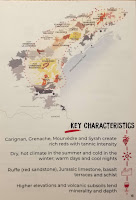
In late March, 17 producers from
Provence descending on Washington, D.C. (as well as other U.S. cities) to present their signature dry rosé wines. I was fortunate to be on the invite list and sampled almost all of these, as well as a few white and red wines produced in southern France. For those who have followed our coverage of
Languedoc and Rhone, Provence is located east of the former and south of the later. Just look for Marseille and Toulon on the map. It is a classic Mediterranean climate with on average 2,900 hours of sunshine per year, mild winters, and little rainfall. Prevailing winds and cooler night time temperatures cool the grapes - with more pronounced cooling at higher elevations.
Provence is an ancient wine growing region. Although the region was the first Roma

n province outside of Italy (Provincia Romana); it was Greek sailors who introduced viticulture and wine making to Provence. The "birthplace of the French vineyard". The Greeks at the time specialized in pale rosé wines which continued even when the Romans introduced red wines. Today Provence is the only wine region worldwide that specializes in rosé - a 2,600 year old tradition.
In France, rosé wines are generally created using one of two processes. In the first, rosé wines are produced by the Saignée method or bleeding of red wine grapes. During maceration, the crushed grapes soak on their skins, which impart color into the juice. After maceration or when enough color has been imparted, some of the juice is bled off in order to add concentration to the reds. The run-off juice is then fermented into a separate rosé wine. Two wine styles for the cost of one. The second method is direct pressing of the grapes. This technique results in a lighter colored wine because the grapes have less contact with the skins.
In Provence

, the grapes used to produce rosé wine are usually Grenache, assembled with other varieties into the final wine. At this tasting the blends included usually Grenache with Cinsault, Carignan, Syrah, or Mouvedre; and sometimes Cabernet Sauvignon, Tibouren, and Rolle (Vermentino). The later two add fragrance and aromatics to the final blend "lending rosé a particularly rich bouquet".
At the Washington DC tasting, I started with an old friend,
Caves d'Esclans. Four years ago I tasted my first d'Esclans and have been hooked since. Due to budgetary constraints I stay with their "lower" end wines but today I was able to sample their higher end portfolio such as the $90 Garrus and $70 Les Clans. The grapes for the Garrus were harvested from a single vineyard and 80-year old vines. The two wines consist of both Grenache and Rolle (Vermentino) and show how rosé wines can have texture and creaminess. A little oak goes a long way. Their mid-price Chateau d'Esclans ($35) is just as nice. Hard to move on from here.
As I continued tasting, I learned more about the regions and grape varieties. At
 Château Gassier
Château Gassier, I learned about the long hot growing season (325 days of sun) and what general attributes that the big three (Grenache-grapefruit, Cinsault-strawberry, Syrah-red currant) add to the wines. And their 946 cuvée ($30) was very nice, a multi-grape assembly of Syrah, Grenache, Cabernet Sauvignon, Carignan, and Cinsault. The 946 refers to the vineyards altitude in meters.
I seemed to enjoy the maritime wines such as the
Les Maitres Vignerons de la Presqu'ile de Saint-Tropez Château de Pampelonne Rosé ($19). This is a joint venture between nine producers and a blend of Grenache, Cinsault, Syrah, and Tibouren. And the organic shoreline vineyard at
Château Léoube was pouring their Rosé de Léoube - a dry, refreshingly acidic blend of Grenache, Cinsault, Syrah, and Mourvèdre that is an amazing value at $11.
Like most wine regions, Provence is populated by historical vineyards. At
Mas de Cadenet, the Negre family has been tending vines since 1813, where the seven generations have survived the Phylloxera epi

demic and debilitating weather. In 1956 Provence experienced three weeks where the temperature fell below -23C, not many cold climate hybrids could survive those temperatures. Today Matthieu Negrel shares the winemaking duties with his sister and father, who took over the family operation 33 years ago. And at
Chateau Roubine, Valeria Rousselle has a domain that was first farmed by the Knights Templar in the 1300s. Today it is a respected Cru Classé and there rosé cuvée is produced from the saignée of their red cuvée. They also were pouring a tasty white wine made from Ungni Blanc, Sémillon, Rolle, and Clairette - grapes that are not very familiar to most U.S. consumers.
Each wine I tasted is worth revisiting and there were too many to describe in one sitting or tasting. Here are a few more wines that I had noted. Mouvedre finally came on my radar with the
 Saint-André de Figuière
Saint-André de Figuière Vielles Vignes, a wine with balance from head to tail and texture. The
Domaine de la Fouquette was pouring their Rosée d'Aurore that was pure citrus.
Château Ferry Lacombe was pouring several wines with all composed of Grenache and Syrah. My favorite was the Cuvée Cascaï ($12) which also contained Cinsault that was harvested from some of the domain's oldest vines. This wine had a texture not found in many rosés and was simply fantastic. As was the Grenache, Cinsault, and Tibouren blend from
Rimauresq Classique, Cru Classé ($20).
Make sure you visit the
Vins of Provence to learn more about Provence and their incredible wine history.






































